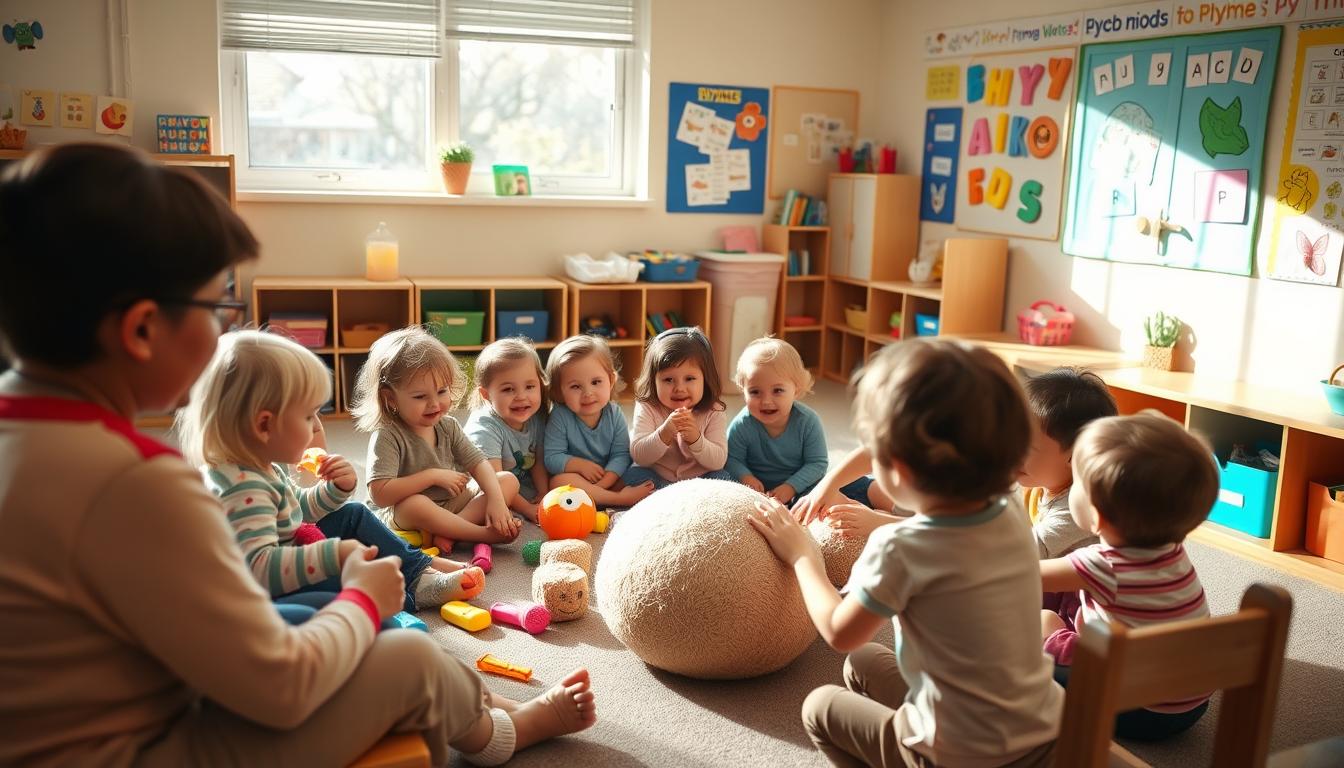Fun Rhyming Games for Preschoolers
“The more that you read, the more things you will know. The more that you learn, the more places you’ll go.” – Dr. Seuss. This iconic wisdom captures the magic of early language development, where playful exploration shapes lifelong skills. For young learners, discovering patterns in words isn’t just entertaining—it’s a critical step toward reading success.
Studies show that playful word activities help children recognize sound structures, a skill linked to stronger literacy outcomes. Through joyful interactions, little ones build listening abilities and neural connections that prepare them for academic challenges. These moments turn snack time, car rides, or playdates into opportunities for growth.
Educators and researchers emphasize that matching sounds isn’t about memorization—it’s about curiosity. Whether clapping syllables or guessing silly word pairs, kids develop phonological awareness naturally. Best of all, these exercises adapt effortlessly to individual needs, creating inclusive experiences for groups or one-on-one bonding.
Key Takeaways
- Sound recognition activities strengthen foundational reading skills
- Experts link early phonological practice to long-term academic success
- Adaptable methods work for homes, classrooms, or mixed-age groups
- Pattern identification boosts memory and listening comprehension
- Playful learning maintains engagement while teaching core concepts
Introduction to Rhyming and Early Literacy
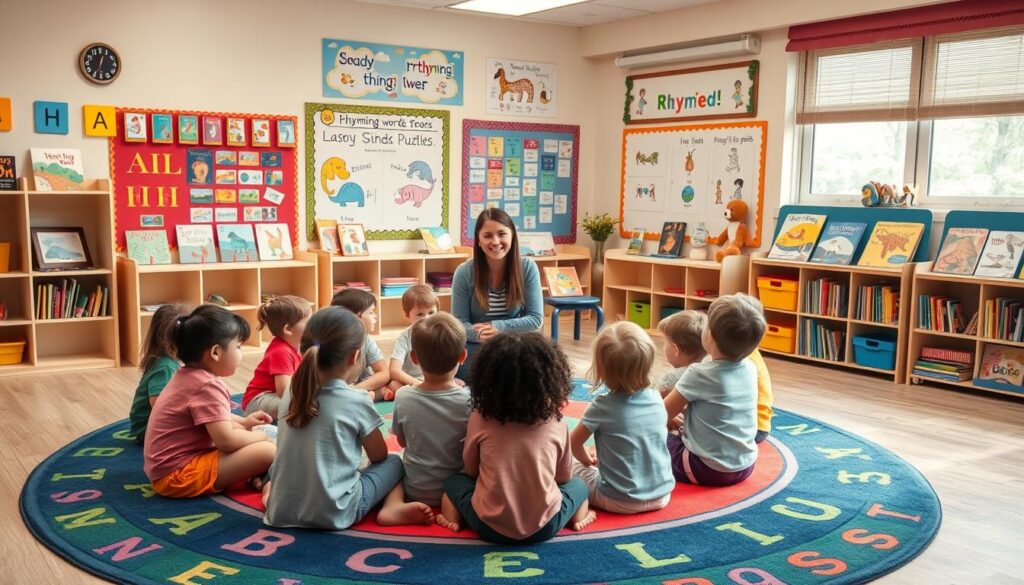
Imagine words as puzzle pieces that click together through matching sounds. This “musical chairs” of language forms the bedrock of early literacy. When little ones notice that cat and hat share endings but mean different things, they unlock a critical thinking skill.
“Phonological awareness provides the foundation for reading acquisition.”
Playful sound exploration helps kids break words into parts naturally. Clapping syllables or singing nursery rhymes trains ears to detect patterns. These activities build the auditory discrimination needed for decoding letters later.
Three key benefits emerge from early sound play:
| Skill Area | Activities | Outcomes |
|---|---|---|
| Sound Recognition | Matching word endings | Prepares for phonics instruction |
| Memory Development | Repeating rhyme chains | Strengthens recall abilities |
| Vocabulary Growth | Exploring word families | Expands language comprehension |
Educators observe that children who master these patterns approach books with excitement. They recognize familiar sounds in new words, making reading feel like solving fun mysteries. This confidence often carries into spelling and creative writing tasks too.
Understanding Phonological Awareness in Young Learners
Young minds blossom when they grasp the music of language. Phonological awareness acts like sound radar, helping kids detect patterns in spoken words. This skill lets them play with language parts long before they recognize letters.
Building Blocks of Sound Recognition
Three layers form this critical foundation: syllable awareness (clapping word parts), intra-syllable awareness (hearing “b” + “at” in bat), and phonemic awareness (identifying individual sounds). Rhyming lives in the middle layer, helping children blend word chunks naturally.
Progressive Learning Steps
Kids master sound patterns through four stages:
- Spotting matches: “Do ‘cat’ and ‘hat’ sound alike?”
- Choosing partners: “Which rhymes with ‘moon’—spoon or tree?”
- Finding misfits: “Which doesn’t belong—dog, log, or sun?”
- Creating pairs: “Tell me a word that rhymes with ‘bed’.”
This step-by-step approach prevents frustration. Children gain confidence as they move from simple identification to creative wordplay. Educators use these milestones to tailor activities that match each learner’s readiness.
Research shows that kids who progress through these stages often excel in reading. They develop sharper listening skills and better memory for word patterns. Most importantly, they learn that language is something to explore—not just repeat.
Benefits of Rhyming Games for Preschoolers
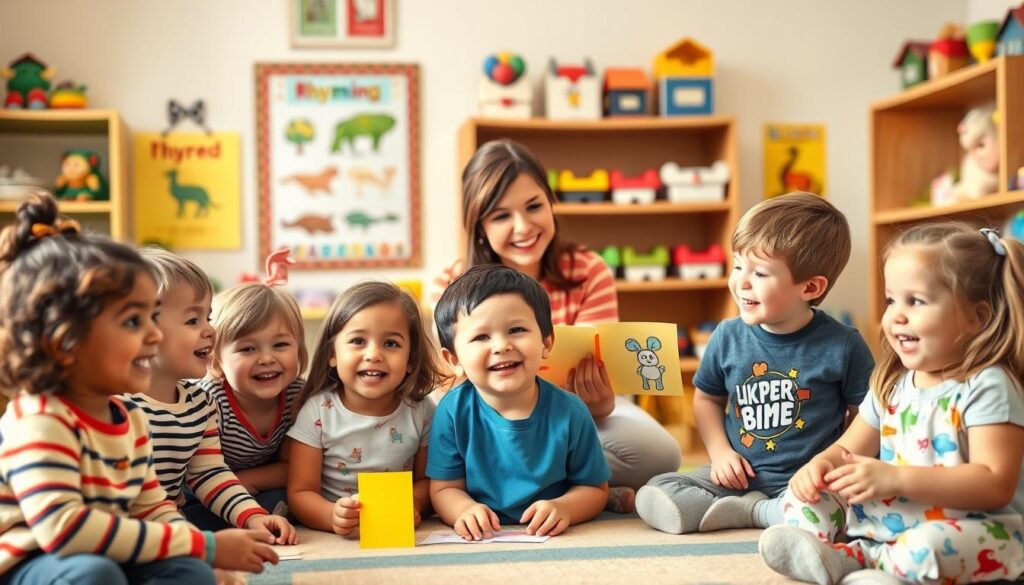
Laughter fills the room as little learners clap out matching sounds—proof that education can be delightful. These playful exercises turn language building into joyful discoveries. Through giggles and creative wordplay, kids strengthen skills that form reading readiness.
Sound-based activities sharpen listening abilities in unexpected ways. Children learn to catch subtle differences between similar endings like cat and cap. This auditory workout prepares them for phonics lessons while keeping energy levels high.
| Developmental Area | Activity Example | Long-Term Advantage |
|---|---|---|
| Auditory Processing | Identifying mismatched pairs | Improved spelling accuracy |
| Word Families | Creating silly chain rhymes | Faster vocabulary growth |
| Social Skills | Group chanting games | Stronger teamwork abilities |
Regular practice builds mental flexibility through pattern recognition. Young minds start connecting sounds to meanings naturally. This helps them decode new words during storytime adventures.
Confidence blooms when kids realize they can manipulate language. They experiment with made-up words without fear, knowing playfulness is part of learning. This freedom often leads to surprising creativity in self-expression.
Memory gets a boost through repetitive, rhythm-based challenges. The musical quality of rhymes makes information stick like catchy song lyrics. Parents notice improved recall during everyday conversations too.
Top Activities to Boost Sound Pattern Recognition
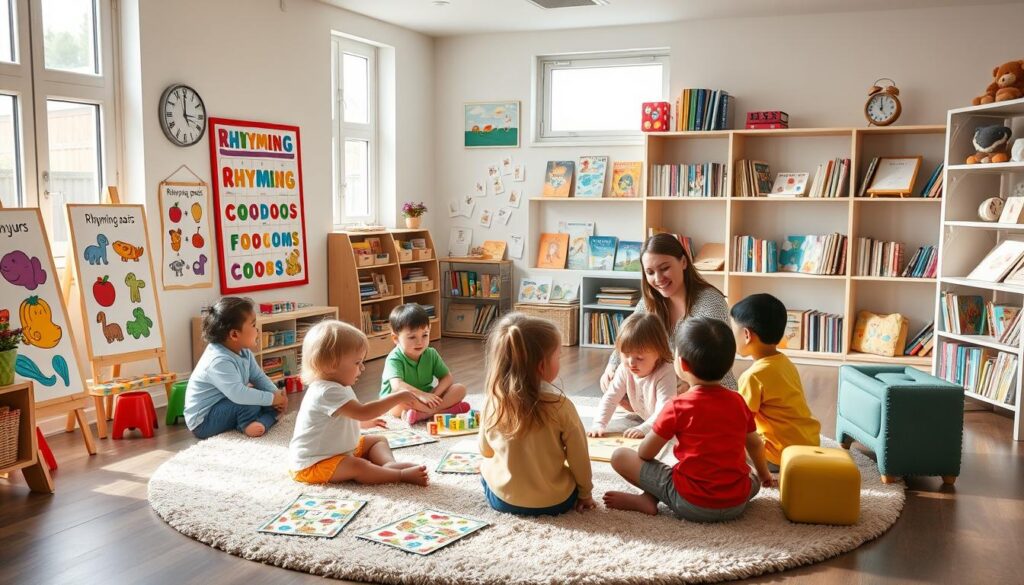
Giggles erupt as tiny detectives hunt for sound-alike treasures around the classroom. These playful adventures turn ordinary spaces into discovery zones where language skills blossom naturally. Multi-sensory approaches work best—combining movement, colorful visuals, and catchy chants keeps young minds fully engaged.
“I Spy a Match” transforms any room into a learning lab. Little explorers identify pairs like “chair-bear” or “clock-sock,” developing sharp listening skills through real-world connections. This approach helps children understand that words exist beyond flashcards.
Classic favorites get clever upgrades to reinforce sound patterns. A modified Memory version uses picture cards with endings that pair up. Go Fish becomes “Go Match,” where players ask for words ending with “-at” or “-ight.” These twists maintain familiarity while targeting specific skills.
| Activity Type | Key Components | Learning Outcomes |
|---|---|---|
| Digital Hunts | Interactive whiteboard puzzles | Tech literacy + sound differentiation |
| Movement Challenges | Hopscotch with word families | Motor skills + quick thinking |
| Storybook Adventures | Finding rhymes in favorite books | Reading comprehension + prediction |
Outdoor options let energetic learners jump rope while chanting word chains. This physical component helps cement sound patterns through rhythm and repetition. Teachers report better focus during seated tasks after these movement breaks.
Smart activity rotation prevents boredom while addressing diverse needs. One group might sort objects by endings, while another creates silly songs. This flexibility ensures every child progresses at their pace, building confidence through joyful challenges.
Interactive Rhyming Lotto and Bingo Games
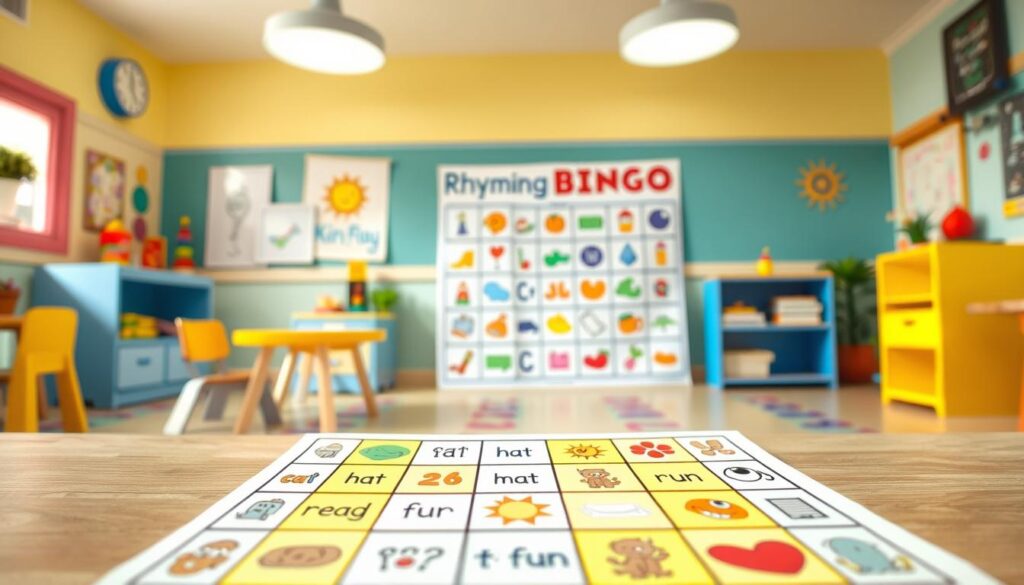
Brightly colored cards transform learning into a treasure hunt for matching sounds. This classroom favorite gets an educational twist where excitement meets skill-building. Little hands eagerly await each clue, ready to pounce on perfect pairs.
Game Setup and Materials
Create custom cards featuring familiar objects like star, moon, and tree. Use picture cues for pre-readers or written words for older kids. Gather buttons, cereal pieces, or mini erasers as markers—items that add tactile fun.
Three simple steps launch the activity:
- Call out target words clearly
- Let players scan their boards
- Celebrate matches with cheers
Key Learning Outcomes
Critical listening grows as ears tune into subtle sound patterns. Scanning multiple options builds quick decision-making. Tiny fingers gain dexterity while placing markers precisely.
| Skill Developed | Game Feature | Real-World Benefit |
|---|---|---|
| Sound Differentiation | Identifying matching endings | Stronger reading readiness |
| Focus & Attention | Tracking called words | Improved classroom participation |
| Social-Emotional Growth | Group celebration of wins | Positive peer interactions |
Teachers love how difficulty adjusts seamlessly. Swap simple CVC terms like cat for advanced pairs like lightning/brighten. The thrill of shouting “Bingo!” never gets old, making this a repeat-requested activity.
Engaging Rhyming Challenges and Matching Activities
Tiny hands clap in rhythm as voices chant matching sounds—a classroom transforms into a discovery zone. These interactive challenges turn language exploration into collaborative adventures where every success sparks excitement.
Ball Pass Wordplay
Gather learners in a circle with a soft ball. Start by tossing it to a child while saying “cat.” The receiver shouts a matching word like “hat” before passing it on. This lively activity builds quick thinking and teamwork as kids listen, respond, and move.
Picture Match Adventures
Create pairs using magazine cutouts or hand-drawn pictures. Spread them face-down for memory games or sort them into groups. Little detectives flip cards to find matches like star-car or tree-bee, blending visual cues with sound patterns.
| Activity Type | Materials | Skills Developed | Adaptability |
|---|---|---|---|
| Ball Pass | Soft ball, word list | Social interaction, rapid recall | Adjust word difficulty |
| Picture Match | Images, cards | Visual memory, categorization | Use photos or drawings |
Educators love how these tasks grow with students. Beginners match obvious pairs like dog-log, while advanced learners tackle caterpillar-pillar. The mix of movement and focus keeps energy high while teaching core skills.
Outdoor and Movement-Based Rhyming Games
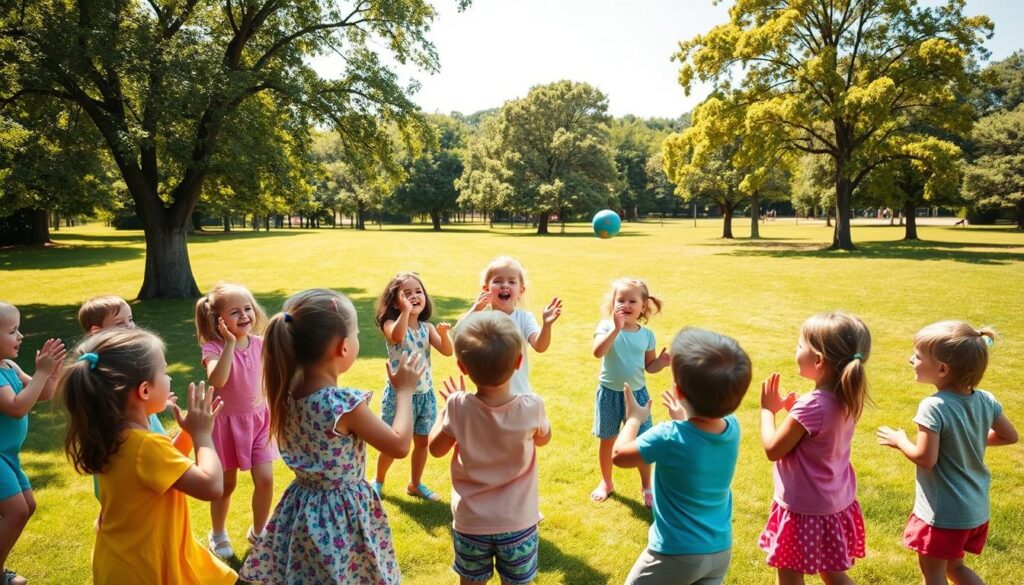
Sunlight dances across the playground as little feet sprint toward sound matches. These high-energy activities blend language development with physical exercise, creating natural learning moments. Rhyming Race turns any open space into a discovery zone—attach pictures to shirts and let the hunt begin!
When the leader shouts “Rhyme Race!”, partners dash to unite their matching pairs. This movement-rich challenge sharpens listening skills while burning off energy. Educators note improved cooperation as children strategize and celebrate together.
Hopscotch gets a clever upgrade with sound patterns drawn in chalk. Jumpers land on squares while calling out matches like log-frog or house-mouse. The rhythmic motion helps cement word families through muscle memory and repetition.
| Activity | Key Benefits | Group Size |
|---|---|---|
| Sound Tag | Quick decision-making | 6-15 players |
| Sidewalk Chalk Match | Creative expression | Individual or pairs |
These outdoor options work wonders for diverse learners. Breezy environments lower stress, letting children experiment freely. Teachers report better focus in class after these active sessions—proof that play and learning make perfect partners.
Classroom Rhyming Games for Whole Class Involvement
A hush falls over the room as twenty pairs of eyes track their teacher’s every move. Whole class participation turns language practice into shared adventures where every student contributes. The “Cross the River” challenge exemplifies this approach—children line up with picture cards, ready to leap into action when their sound match gets called.
These collaborative exercises eliminate wait times through constant engagement. As the teacher strolls between imaginary riverbanks, learners sharpen listening skills while anticipating their turn. Quick reactions get rewarded with cheers from peers, building confidence through group support.
Educators gain real-time insights into skill levels while fostering teamwork. Observing which students hesitate helps tailor future lessons. Meanwhile, classmates naturally model successful strategies during play, creating organic learning moments.
Large-group activities strengthen classroom bonds through shared triumphs. The thrill of collective achievement makes pattern recognition feel like solving mysteries together. This approach transforms routine practice into memorable experiences that stick long after the lesson ends.
Through creative twists on classic formats, teachers cultivate environments where risk-taking feels safe. Whole class participation demonstrates that language exploration thrives best in joyful, connected communities. These moments lay groundwork for lifelong literacy love—one playful splash across the riverbanks of imagination at a time.
FAQ
How do rhyming activities support early literacy skills?
What are simple rhyming challenges for preschoolers?
Can movement-based activities teach rhyming effectively?
How can I adapt rhyming lotto for different skill levels?
Why include rhyming picture sorts in lessons?
What classroom games work best for group participation?
How do I assess a child’s rhyming skill development?

Adam Peter is a finance, travel, and automotive writer with over a decade of experience. He creates clear, practical content to help readers manage their money, explore the world with confidence, and make informed decisions about cars and travel gear. His work blends expert insight with real-world usefulness.

